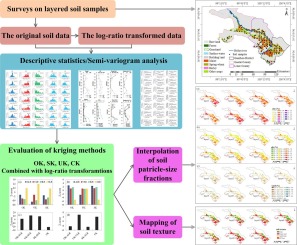Catena ( IF 5.4 ) Pub Date : 2020-02-18 , DOI: 10.1016/j.catena.2020.104514 Jiang Li , Heyang Wan , Songhao Shang

|
Soil particle-size (clay, silt, and sand) fractions and texture maps are key inputs for soil physical, chemical, hydrological, agricultural, and ecological models. In the current study, ordinary kriging (OK), simple kriging (SK), and universal kriging (UK) combined with additive, centered, isometric and symmetry log-ratio (ALR, CLR, ILR and SLR) transformations and compositional kriging (CK) are used to map the layered soil texture and to interpolate the soil particle-size fractions based on soil surveys in the middle reaches of Heihe river basin in Northwest China. Results depicted that silt loam is the dominant soil texture in soil profiles of 0–140 cm, accounting for almost 50% in the study area. Layers 3–5 (soil depth of 40–100 cm) show the strongest spatial dependency of soil particle-size fractions as compared to other layers. The results revealed that soil particle-size fractions and soil texture interpolation are dependent on the proper selection of interpolation methods. SLR transformation are better than other log-ratio transformations when interpolating each soil particle-size fraction using different kriging methods. However, for interpolating soil texture types, ALR transformation is the best for OK and SK, and CLR for UK. UK-SLR is recommended to interpolate soil particle-size fractions for all soil layers, and UK-CLR to interpolate the layered soil texture of the study area. More than eighty soil samples should be taken to get a higher soil particle-size fractions/soil texture interpolation precision.











































 京公网安备 11010802027423号
京公网安备 11010802027423号